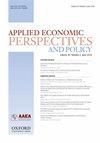消费者如何改变他们的食品杂货支出,以应对补充营养援助计划福利慷慨的变化?
IF 3.4
2区 经济学
Q2 AGRICULTURAL ECONOMICS & POLICY
引用次数: 0
摘要
在本文中,我们使用Circana的数据研究了减少补充营养援助计划(SNAP)福利对杂货购买的影响。我们使用一个估算的差中差模型来利用各州在决定取消大流行时期SNAP紧急拨款方面的差异,以估计此类政策的影响。我们发现,SNAP家庭对取消SNAP紧急拨款的反应是,他们的杂货支出平均减少了4.6%,将24.1%的杂货账单用信用卡支付。这些结果适用于以黑人和白人个人为首的SNAP参与者以及有孩子的家庭。本文章由计算机程序翻译,如有差异,请以英文原文为准。
How did consumers change their grocery spending in response to changes in Supplemental Nutrition Assistance Program benefit generosity?
In this paper, we examine the impact of reducing Supplemental Nutrition Assistance Program (SNAP) benefits on grocery purchases using data from Circana. We use an imputed difference-in-difference model to exploit state-level variation in decisions to remove pandemic-era SNAP emergency allotments to estimate the impact of such policies. We find that SNAP households respond to the removal of SNAP emergency allotments by reducing their grocery expenditures by 4.6% on average and by putting 24.1% more of their grocery bills on credit cards. These results hold for SNAP participants headed by Black and White individuals and for households with children.
求助全文
通过发布文献求助,成功后即可免费获取论文全文。
去求助
来源期刊

Applied Economic Perspectives and Policy
AGRICULTURAL ECONOMICS & POLICY-
CiteScore
10.70
自引率
6.90%
发文量
117
审稿时长
>12 weeks
期刊介绍:
Applied Economic Perspectives and Policy provides a forum to address contemporary and emerging policy issues within an economic framework that informs the decision-making and policy-making community.
AEPP welcomes submissions related to the economics of public policy themes associated with agriculture; animal, plant, and human health; energy; environment; food and consumer behavior; international development; natural hazards; natural resources; population and migration; and regional and rural development.
 求助内容:
求助内容: 应助结果提醒方式:
应助结果提醒方式:


